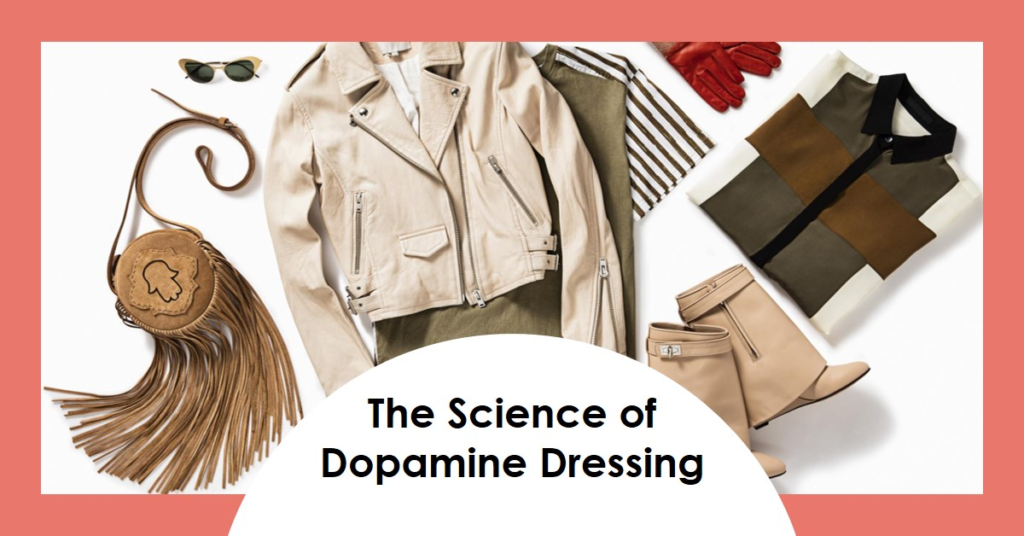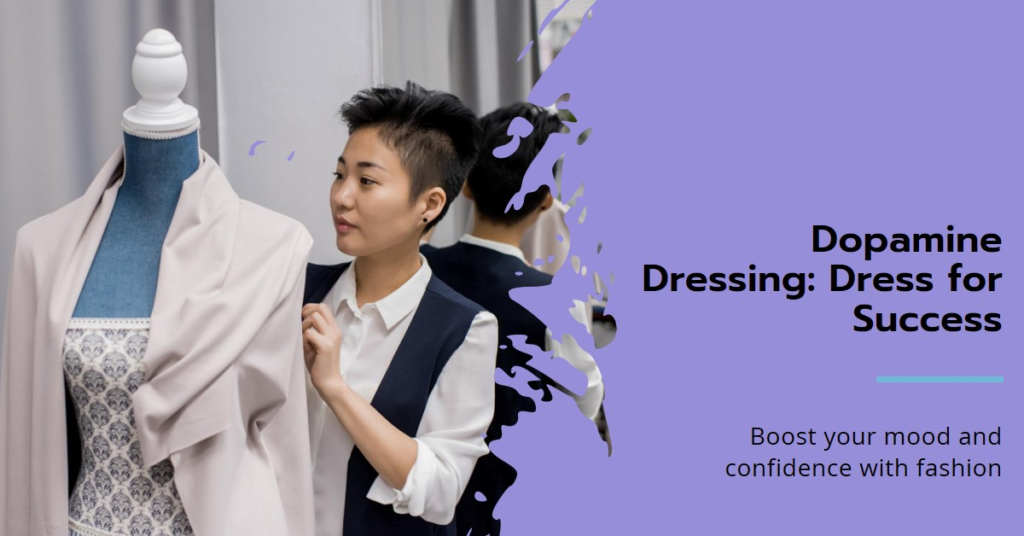Dopamine Dressing: Bold Colors, Big Mood
Colors and styles shape our feelings. Fashion isn’t about looks – it’s mood medicine. Slip on that favorite shirt, and watch your spirits soar. Your brain rewards you with a dopamine rush, flooding you with joy. This chemical magic transforms confidence and outlook. Dopamine dressing harnesses fashion’s power to uplift. It’s not vanity, but self-care through smart wardrobe choices. By donning pieces that spark delight, we empower ourselves. Our clothes become tools for well-being, not mere coverings. This fresh approach celebrates fashion’s hidden strength: its ability to nurture our minds.
The Science Behind Dopamine Dressing

Dopamine dressing taps into the power of clothing to influence our emotions. Some outfits can spark joy. They can trigger a dopamine release, a pleasure-linked chemical. Research shows a link between what we wear and how . It offers a new view on the psychology of fashion. Selecting our clothes with care may enhance our mood and well-being. This phenomenon’s science shows a link between our clothes and mood.
Dopamine, a crucial neurotransmitter, shapes our emotional landscape. This chemical messenger orchestrates mood, drives motivation, and sparks pleasure. It also weaves a tapestry of our feelings. It shapes how we experience and express emotions in daily life.
Color and Mood: Studies suggest that certain colors can boost dopamine in the brain. This affects our emotions and perceptions. For example, red can boost performance. Green can spark creativity and relaxation, as it’s linked to nature.
Enclothed Cognition: This term means clothes impact our minds and actions. For instance, a doctor’s white coat can enhance thinking and change behavior. Also, colors and clothes can affect mood. But they vary by a person’s background and memories. Dopamine dressing means wearing what makes you feel good, not following trends.
Material and Texture: Besides color, the clothes’ material and texture can affect mood. Softer, roomier clothes can evoke relaxation. Different fabrics can affect emotions through their senses and psychology.
Creative Expression: Using different colors, patterns, and styles can express creativity. It can also trigger a dopamine release. This creative process allows individuals to express their personality and feel more confident.
By understanding these principles, people can use dopamine dressing. It means choosing clothes that boost their mood and well-being.
How to Incorporate Dopamine Dressing

To use dopamine dressing, follow a few steps. They will help your clothes boost your mood and confidence. Here are some concise tips:
Keep a Clothing Journal: Track how outfits make you feel. This will help you find patterns and preferences. It helps you find what boosts your mood and what doesn’t. You can then build a wardrobe that always makes you feel good.
Experiment with Colors: Wear different colors. Find which ones bring you joy and boost your mood. Colors like yellow, orange, green, blue, and purple have effects. They can boost energy, promote relaxation, and invoke sophistication.
Clothing should cradle both body and spirit. Soft fabrics and loose fits soothe the skin, while comfortable shoes pamper feet. But true style transcends physical ease – it lifts the soul. Wear confidence. Don elegance. Drape yourself in garments that speak to your inner self and radiate assurance.
Balance Individuality and Social Fit: Show your uniqueness. Yet, consider the social setting for your clothes. Use accessories to add personality without being out of place. Empowering Underwear: Good underwear is often overlooked. However, wearing attractive, empowering underwear can provide a substantial increase in your confidence.
Start small and gradual: small tweaks to your wardrobe. Take your time to experiment with new styles. This can include coordinating a dress-up party with friends. It’s a way to experiment in a safe, supportive environment.
Embrace Personal Preference: Wear clothes that make you feel good. They should reflect your style, not trends. This ensures your clothes reflect your true self.
Texture and Material: Pay attention to the tactile effects of clothing. Choose materials that evoke specific feelings, like coziness or sensuality. This will enhance your mood. By following these steps, you can use dopamine dressing. It uses fashion to boost your mood and well-being. Clothing’s power extends beyond mere style. It can lift spirits and shape mindsets. Dopamine dressing, a rising trend, harnesses this potential. By choosing vibrant, expressive outfits, wearers aim to boost mood and confidence. Designers have long recognized fashion’s transformative effects on both appearance and attitude. As Jonathan Saunders noted, attire reflects identity.
This way of dressing will boost happiness, mindfulness, and confidence. It’s a deliberate use of wardrobe to influence one’s emotional state and outlook. Vibrant hues spark joy, triggering our brain’s reward center. This neurochemical boost underpins the dopamine dressing phenomenon. Fashion meets neuroscience as we don bright shades to elevate our spirits. Color psychology illuminates how our wardrobe choices influence mood. Uplifting tones can boost well-being. They use the power of visuals. Our attire becomes a tool for cultivating positivity and pleasure in daily life.
Red pulses with passion, quickening hearts and sparking action. Yellow radiates warmth, fostering joy and optimism. Blue’s serene hues evoke sky and sea, soothing the soul. Green echoes nature’s vitality, symbolizing growth and renewal. These colors influence our moods and behaviors in a nuanced way. Their influence seeps into our subconscious. Our chosen colors, in clothes or surroundings, shape our emotions. They paint our daily experiences with a hidden, powerful psychology. Designers use these psychological effects to create collections.
They embody the dopamine dressing philosophy. Designers often use bold, vibrant colors and patterns. They craft garments that stand out and resonate with the wearer. The trend urges people to dress to reflect their mood. It promotes using color for self-expression and emotional wellness.
The fashion industry has seen a rise in collections. They feature bright and pastel colors to invoke joy and playfulness. This departs from the minimalist aesthetic that dominated the last decade. It signals a shift to more expressive, mood-boosting fashion. The trend is not about individual pieces. Styling them together is also important. The goal is to create a look that is both striking and moving. Elevate your mood with strategic wardrobe choices. A vivid scarf enlivens muted outfits, while crimson footwear energizes each step.
Sunny tops radiate cheer throughout your day. Dopamine dressing is about finding pieces that resonate. It’s not about revamping your entire closet. Opt for items that spark joy and boost confidence. Statement earrings can transform your outlook. Choose clothes and accessories that lift your spirits and make you feel extraordinary. In conclusion, dopamine dressing is a trend. It shows how our clothes affect our feelings. By using color psychology and designers’ advice, individuals can empower themselves through clothing. They can create a wardrobe that looks and feels good. Fashion can then enhance their daily lives.
Dopamine dressing goes beyond fashion. It seeks the mental health benefits of our clothing choices. This trend suggests that certain colors and styles can trigger dopamine release. This neurotransmitter affects our pleasure, satisfaction, and motivation. Wearing clothes that boost this “feel-good” chemical can improve mood. It can also enhance well-being. Dopamine dressing lifts spirits in our anxious world. A bright outfit can lift a gloomy mood. It shows the power of clothing to affect emotions.
This proves particularly potent for those battling Seasonal Affective Disorder. As winter’s chill sets in, bold hues combat dreary days, boosting mental health. Intentional wardrobe picks thus serve as a powerful tool against stress and sadness. Also, choosing what to wear can be a mindful practice. It lets people connect with the present and their senses.
This mindfulness can be therapeutic. It reduces anxiety and creates calm. The textures of fabrics, the flow of a garment, and the colors can all aid this meditative process. They can foster a more harmonious mental state. Dopamine dressing doesn’t require a radical change to your wardrobe. It calls for a slow shift to more mindful clothing choices. Here are some detailed steps to consider:
Audit Your Wardrobe: Start by going through your current collection of clothes. Hold each item and reflect on how it makes you feel. Keep those that evoke positive emotions and consider donating the ones that don’t.
Add color on purpose: If your wardrobe is mostly neutral, add colored accessories. Use belts, scarves, or jewelry. This method lets you experiment with color without feeling overwhelmed.
Invest in Key Pieces: Find colors that you like. Then, buy key clothes in those hues. A statement jacket, a pair of shoes, or a hat can all be simple starting points.
Layering adds a nuanced touch of color. A hint of color under a jacket or cardigan can boost your mood.
Embrace Patterns: Patterns can boost mood like solid colors. So, pick joyful patterns and add them to your outfits.
Plan Your Outfits: Prepare your outfits in advance. Choose pieces that you associate with positive experiences or feelings. This can help set a positive tone for the day ahead.
Reflect and Evolve: Consider how your clothes influence your mood on a regular basis. Use this insight to evolve your wardrobe over time. It should align with the principles of dopamine dressing.
By adding dopamine dressing to your wardrobe in a gradual manner, you can boost your mood. It may improve your mental health. This fashion approach is not about looking good. It’s also about connecting with oneself. It aims to build a wardrobe that boosts one’s mood.
For more information on dopamine dressing, visit The Wardrobe Consultant.



